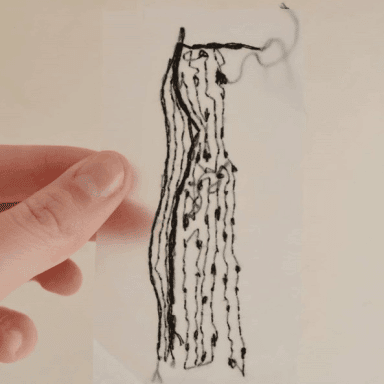

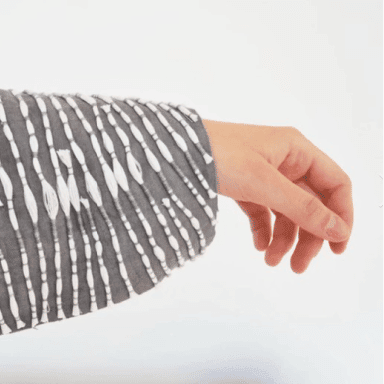

The want to live and create sustainably envelops Francesca’s work; this much is evident to anyone that glances at her Instagram and website posts where photographs of delicately embroidered fabrics and organic forms in stitching are accompanied by comments frequently referencing her natural inspiration. These organic forms in thread have not come about for aesthetics’ sake alone; Francesca is part of a movement that is challenging the way we produce and consume garments. Through her studies at the Duncan of Jordanstone College of Art & Design, from which she has recently graduated, Francesca’s mission to challenge the impact our consumption has on the planet has been guided, strengthened, and found its voice in the creation of sustainable and eco-conscious burial garments presented in her final year’s project. I spoke with her about this project, her impressions (as a textile artist and relative outsider) of the death industry, and her plans for the future.
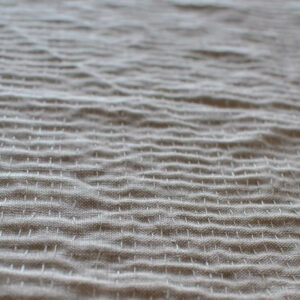

Could you tell us a little bit about your burial garment project?
Every life has an ending, and for humans this is a heavily contemplated advent. However, even with the existing sustainable options for burials, the materials that that body is clothed in are not often considered. It is estimated that 65% of all fibres used in the clothing industry are made from synthetic material. Long after a body has decomposed these materials remain in the ground and take hundreds of years to break down, releasing harmful chemicals in the process. Using the slow and thoughtful process of embroidery, I have designed textiles for burial-wear with fabric that is eco-friendly to produce and 100% decomposable, such as plant and animal-based materials and natural dyes. Bio-degradable matter, once dead and decomposing, adds nutrients to the ground which allows for new life to grow. This life cycle closely connects people to nature and provides the visuals for my design. I have drawn from disintegrated leaves as a reminder of our place in the environment, one that we must look after for the next generations in the cycle. Some of the techniques and materials used are inspired by traditional Irish crafts and the ancient burial rituals of my predecessors. Textiles have great significance within society, throughout history and across cultures; they tell stories, provide warmth and comfort and play an important role in specific occasions and rituals. New life is often accompanied by textiles, the swaddling blanket helps the baby feel safe and contained as it adjusts to life outside the womb. The same is sometimes done with the deceased; as a salve, a cover, for remembrance and memorial. My project aims to open the discussion around death and the rituals and practices that surround it. With beautiful, thoughtful textiles in natural materials we can return loved ones to the earth with ceremony that has aligns with the balance of nature.
What is the background to your project, and what inspired you to delve into the niche of burial clothing?
I was speaking to a family member who went to a funeral where the deceased was buried in a wicker casket, and I thought that was very cool but I automatically questioned what she wore in the casket, since I study textile design I’m always thinking about materials. This family member was also helping me figure out a concept for my final year project, and he thought shrouds for the grave was a great idea. At first I said no way, because I’m 22 death isn’t something that crosses my mind often and I thought it would be too morbid. But the more research I did the more I realised I could incorporate the themes that ARE of a great concern to me (environmental impact of textiles) and make the project a positive one.
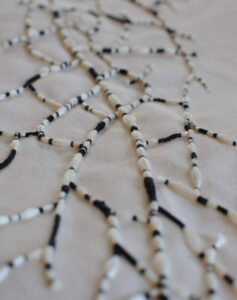

What research did you do for the project?
For my project’s concept I began researching ancient Irish traditions and celebrations i.e. pagan traditions and mythological beliefs, and most of these things were connected to death and the afterlife, and compared this to how we view death today. For the visuals of my project I looked into folk art, traditional Irish crafts and other artists and designers who incorporate or mimic nature in their work. The most interesting research for me was discovering innovative and sustainable textiles, e.g. fabric made out of seaweed, algae or nettles. Of course none of these fabrics are commercial yet, so for my project I stuck to traditional cottons, linens and silk, with Irish made linen being the star feature.
What, if anything, surprised you most about the ‘death world’?
During my research I discovered that eco or green burials are gaining popularity, but I almost couldn’t find anyone who had considered what the body will wear in the grave. I asked a friend who works at a funeral directors what people wear for a green burial and he said people are just dressed in a plain robe sort of thing for their burial. I think it made me realise just how little most people know about, so therefore consider, what their clothes are made from.
Another thing I realised during this project is that in other countries around the world death is kind of more accepted, and a bigger fuss is made out of funerals. This could be because of their different beliefs of the afterlife or maybe because more people die at an early age. But in the western world especially, death is scary, and we put it off for as long as possible, and everyone wears black at the funerals and it seems like the worst thing in the world. I’m not saying either of these views of death is wrong, I just found it interesting once I thought about it.
Do you think you’ll be making the garments to sell in the future?
As of now I have no plans to actually make and sell burial garments, even though I think there is a gap in the market for them. But hopefully now that more people are thinking about a green burial, more people will start making sustainable burial clothing.
What is something you would like people reading this to know?
I can’t think of anything else I’d like to add about my project, but I guess in general I’d like more people to think about what their clothes are made from and who has made them. If you buy a £3 t-shirt in Primark, what did the person making it get paid? And isn’t it better to spend money on well-made, ethically made clothing rather than continuously buying cheap clothes that wear out fast? Also, if your clothes do become unwearable, never ever throw them in the bin that goes to landfill.
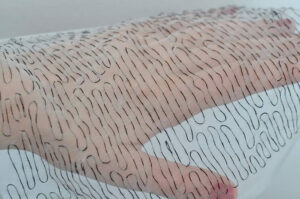

Francesca’s website is:
https://www.francescareatextiles.com/
You can also find her on Instagram


